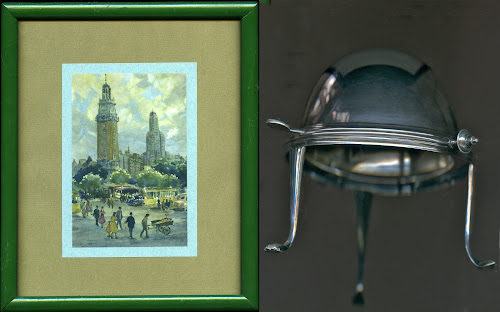 |
| Left La Torre de Los Ingleses in Buenos Aires, Right my mother's English butter dish |
On June 2, 1953, in Buenos Aires, I remember exactly what I was doing. My mother said, “Alex, wash your hands and knees (I wore short pants, I was 10 years old) and come to lunch.” I answered, “I cannot because I am listening to the coronation of my queen.”
On that date, a few hours before the queen’s coronation began at noon, New Zealand born Alleyne Cook was the gardener and the only man working in Constance Spry’s School for Girls in London. Spry told Cook, “You are going to have to cut quite a few flowers as we are in charge of decorating Westminster Abbey for the queen’s coronation.”
My only confusion on the above is that since Buenos Aires was four hours behind London, I must have been listening to a delayed broadcast if I was about to have lunch in BA.
My heritage is complex. My mother was born in Manila and her mother in Valencia. Her father was basque. My father was born in Buenos Aires but his parents were from Manchester and they had moved to Argentina in 1901.
In 1947 my father, mother and I moved to the very English neighbourhood called Coghlan. Coghlan was the name of the nearest train station and it was named after an English train engineer.
Most of my very English family lived either in San Isidro or Acasusso. My guess is that Coghlan was perceived as being English because of the train station's name.
By 1948 I was “el inglesito” on Melián where we lived. I had two friends one Miguelito, who was Italian was “El Tano” and my other friend Mario who was a German Jew was “El Ruso” as even now Buenos Aires Jews are called Rusos as the majority of them came from Russia before the wars.
At home we
spoke English. My father was very English and he was journalist for the English
paper, Buenos Aires Herald. he smoked Player's Navy Cut Cigarettes and loved gin.
The trains at the Coghlan station, the streetcars (tranvays) and the subte (our subte) all arrived on the wrong side of the station tracks. They had all been built by the English.
I must stop here, that for me, it will always be England and English and I will never utter British or UK!
During my two year stint in the Argentine Navy in the mid 60s I was taught that the stripes on my navy collar represented Admiral Horatio Nelson’s victories.
The founder of our navy Almirante Guillermo Brown, while having been born in Foxford, Ireland we Argentines have always considered him to be English.
While in the navy there was an obscure provision that said that any conscript that donated blood was subject to a day off the next day. I abused this privilege by donating every two months at the Hospital Británico. The folks there gave me a thé completo with scones, cream and jam and a generous cup of tea.
I often went to visit my father’s brother Uncle Freddy who was born in Buenos Aires but he always talked about going home to England. He proudly wore his school blazer from St. Andrew’s Scots School. His wife, my Aunt Iris, made the best devilled ham I have ever tasted. By then I was smoking a pipe so Uncle Freddy and I would smoke our English pipes together.
On the Irish side of the family, the O’Reillys few spoke English but my first cousin and godmother Inesita O’Reilly Kuker (she became a widow and married a German Adolfo Kuker) spoke English beautifully. In 2006 my Rosemary and I took our granddaughter Rebecca to Buenos Aires.
I told Rebecca, “You are going to meet Inesita today. The queen of England talks like her. This is because while they both sound the same Inesita is older than the queen.”
I share my Englishness with Jorge Luís Borges who had an English grandmother and was raised by an English nanny, Miss Tink.
My mother liked to smell me behind the ear and then blow gently into it. She often told me, “Alex you smell like an Englishman.” Or she would tell me that my father sounded and looked like the very English David Niven.
And so I close this blog today, the day of my Queen’s death with this feeling that I feel as English today as I did back in 1953.
Illustrating this blog is my mother’s butter dish. She often told me that she was very attached to it. It has been prominently displayed on the many dinner tables we have had through the years. Once a month I polish it to perfection.






